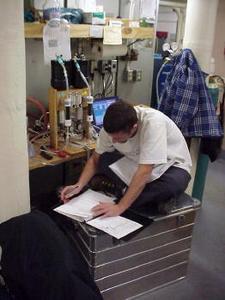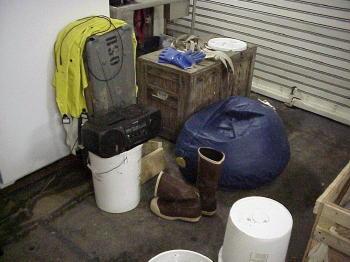
|
|
3 August, 2002
The luxury of a little spare time when we are at a
deep station is gone now that weíre at the end of the
East Barrow transect. We have been moving from deep
water (3000 meters) to shallow (50 meters), and we
will have completed seven stations on this transect by
the time we are done this afternoon (Aug. 4). In
addition, because we are in shallow water again, we
are doing both van Veen grabs and Haps Core sampling.
We can sieve (wash the mud off completely) the mud
from one van Veen grab in 10-15 minutes if the mud is
of the right consistency. If the mud is more
clay-like or has a number of organisms in it, the
sieving process can take 45 minutes Ė one hour/grab.
Lately, itís been taking us more rather than less
time. Weíre definitely finding a lot of ďcritters,Ē
though. Lots of invertebrates (animals without
backbones) live at these cold depths. As Jim Bartlett
(science technician for Jackie and Lee) said last
night, it brings new meaning to the phrase ďstuck in
the mud.Ē
We have been finding Lots of brittle stars (a type of
starfish with long thin arms), a few bat
starfish, several different species of worms, and even
a type of coral! I know that I always thought coral
needed shallow water so the sunlight could get to them
and the algae that live inside them to help them feed.
I also thought they needed warm water! These small
corals (they look like miniature deer antlers) are
living in -1.5 degree Celsius water at a depth of 200
meters! It seems that itís only the colonial (live in
groups), reef building corals that need the shallow,
warm water. The coral we found is doing just fine in
deep, very cold water!
Once we bring up the Haps cores Jackie picks two that
are best suited for her respiration experiments. She
found a good core today and immediately noticed a
sabellid worm near the top. These belong to a group
of worms that form tubes around themselves and just
stick out their front end to filter their food from
the water. They are similar to feather duster worms
and Christmas tree worms found on coral reefs in
tropical waters. You can see the long feathery
spirals for gathering food in the picture below.
Jackie and Lee took several pictures, and then Jackie
brought the chamber inside. Shortly after that, the
worm came completely out of its tube. This provided
the occasion for much excitement and picture taking by
anyone in the lab. Jim and I were working on
sectioning a core, and we both took a break just to
see the worm. OK, admit it. Some of you are shaking
your head and saying, ďget a life, itís only a worm!Ē
Remember, this IS Jackieís life, and she finds it
incredibly exciting! In addition, itís all a part of
this incredible SBI project that is going to provide
so much more information about this relatively unknown
ocean. Her excitement is contagious, and we all were
thrilled to see this unusual life form from the depths
of the Arctic Ocean!
Itís almost time to post my journal, and Iím going to
give e you a brief run down of the past 36 hours.
Just after midnight on August 3 we finished EB 4 (the
4th station on the East Barrow transect) I went to
bed and got up at 7: 00 for breakfast. After
breakfast, I worked on my journals and photographs.
That usually means checking the information with the
scientists I wrote about, editing the journals, and
printing off both the journal and the photographs to
post in the mess. I had to wait until lunch at 11AM
to find Paul and Christine (the two people in the
journal), because they had both been up until 5:30AM
collecting water samples and they slept in until
lunch. At noon I began to post my journals. You
might have noticed that there were no journals for two
days. Thatís because our internet access had been
reduced back to two hours/day, from noon until 2 PM,
and thatís the time frame in which I will now post my
journals. When you think about it, itís pretty amazing
that we have internet at all! Immediately after
finishing my journals at 2 PM we started EB 3, working
on it through 8 PM. We did take time out for dinner
and sabellid photographs! From 8:30 until 9:30 I
collected water for the oxygen-18 sampling. I then
worked on preparing my journal photographs until
10:45. At 11 PM, I went to sleep and got three hours
in before we started EB 2 at 2 AM on August 4. We
completed EB 2 in time for breakfast. I started to
write this and fell asleep! I caught another couple
hours of sleep and here I am, wrapping up my journals
from yesterday so I can post it in 15 minutes, the end
of 36 hours.
We are already at EB 1 and Iíll be heading back to the
science lab as soon as this is posted. The good news
is that we will then be done with the East Barrow
transect, and our next transect is 24 hours away! The scientist will use
that time to gather some of data for the chief scientists and to catch up on
the processing of samples and some sleep! Iíll be able to talk to some of
the scientists so I can fill you in on more of the projects going on.

This is the worm that caused so much excitement yesterday! It's a type of tube worm called a sabellid worm.

Late at night or early in the morning, people get comfortable any way they can. Dan Schuller uses a trunk for a seat while he works on his data.

These are a few of the things that you're likely to see in the area where we work to process and cut our cores: a pair of waterproof coveralls, steel-toed waterproof boots, a CD player, all purpose buckets, rubber gloves for water work, and the ever popular bean bag, one of the best spots to catch a nap while waiting for samples to come to the surface.
Contact the TEA in the field at
.
If you cannot connect through your browser, copy the
TEA's e-mail address in the "To:" line of
your favorite e-mail package.
|
